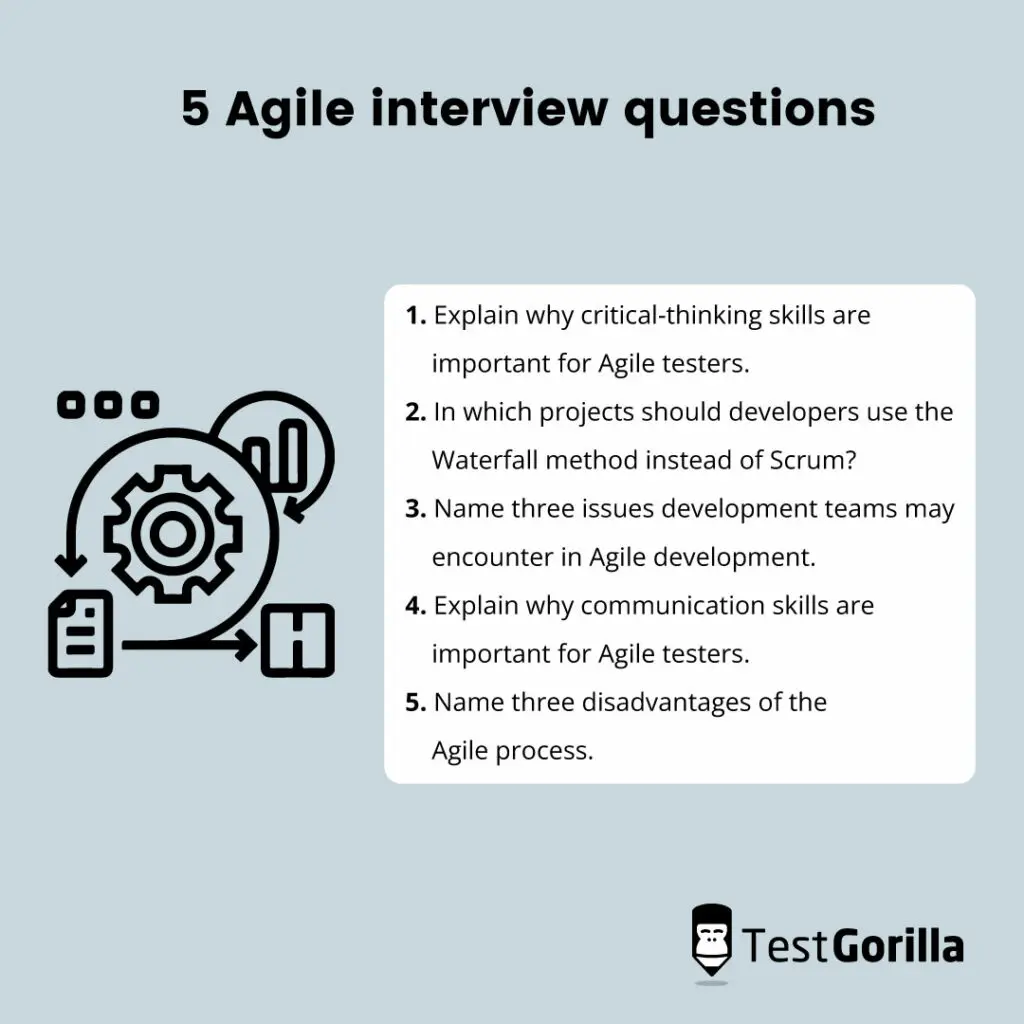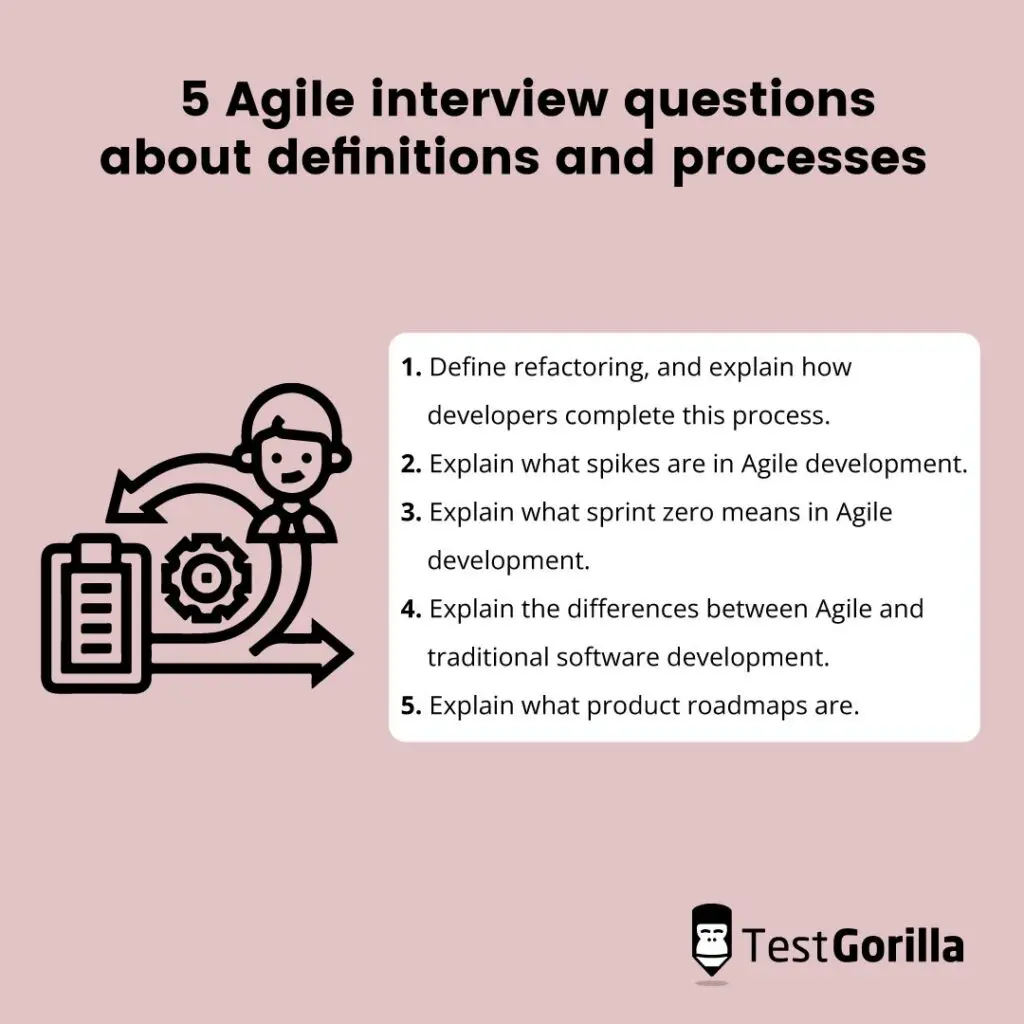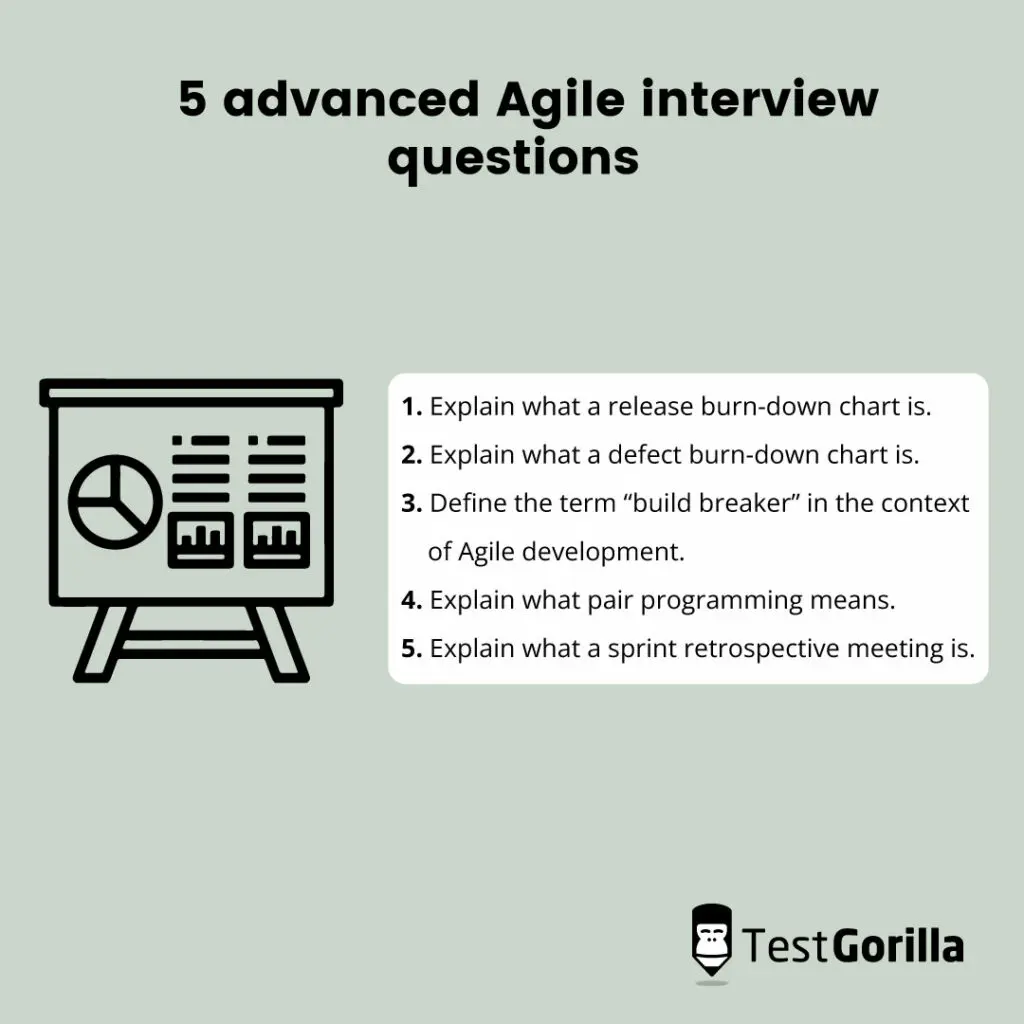Agile is a crucial philosophy and strategy for technology organizations. It enhances team communication, flexibility, and efficiency. If you’re hiring a developer, you should check if your applicants can implement Agile strategies and work in an Agile team.
You can simplify the hiring process by giving candidates skills assessments and asking engaging Agile interview questions. But although it’s easy to find skills tests (such as an Agile Product Owner skills test) for an assessment, gathering Agile interview questions is slightly more challenging. How can you make this process easier?
The simplest way to prepare for interviews with Agile developers is to use the Agile interview questions in this article. We have divided them into beginner questions, questions about definitions, and advanced Agile interview questions. Check the lists below to choose the right questions for your company and open role.
Table of contents
- Beginner Agile interview questions to ask your applicants
- 5 Agile interview questions and sample answers
- Agile interview questions about definitions and processes
- 5 Agile interview questions and answers about definitions and processes
- Advanced Agile interview questions to ask your candidates
- 5 advanced Agile interview questions and sample answers
- Why you should use skills assessments before asking applicants Agile interview questions
- Hire Agile developers for your team with Agile interview questions
Beginner Agile interview questions to ask your applicants
If you are hiring a junior Agile developer, use these beginner Agile interview questions to test your applicants’ skills and experience.
1. What do you understand about the Agile methodology?
2. Tell me what you understand about the Scrum Agile methodology.
3. What do you understand about feature-driven development?
4. Define lean software development.
5. Explain what extreme programming means.
6. Explain what dynamic software development methods are.
7. Define adaptive system development.
8. Tell me what you understand about the crystal methodology.
9. What do you know about Kanban projects?
10. Name three advantages of the Agile process.
11. Name three disadvantages of the Agile process.
12. Define Agile testing in the context of software development.
13. Explain what continuous testing means.
14. Explain what continuous feedback means.
15. Explain what clean code methods are.
16. Explain how less documentation is important for Agile testing.
17. Explain why communication skills are important for Agile testers.
18. Explain why critical-thinking skills are important for Agile testers.
19. Explain why teamwork is important for Agile testers.
20. Name three project management tools that programmers use in Agile development.
21. Name three issues development teams may encounter in Agile development.
22. In which projects should developers use the Waterfall method instead of Scrum?
23. What is the duration of a Scrum cycle?
24. Explain what Scrum of Scrums means.
25. Describe your experience creating burn-down charts.
26. Describe the difference between feature- and test-driven development.
27. Describe your experience participating in daily stand-up meetings.
28. Explain what test stubs are.
5 Agile interview questions and sample answers
Consult the sample answers to these important Agile interview questions to assess your candidates’ responses after the interview.
1. Explain why critical-thinking skills are important for Agile testers.
Critical thinking helps Agile testers make decisions in organizational settings. This skill ensures developers consider how they complete the deployment process and deliver better software products to satisfy end users. It’s also one of the top skills employers think will become more important in the next few years.
Ensure your candidates have the critical-thinking skills needed to complete software development duties for your organization by asking them to complete a Critical Thinking skills test.
2. In which projects should developers use the Waterfall method instead of Scrum?
Applicants familiar with Agile, Waterfall, and Scrum methods will have no problem responding to this Agile interview question. They may explain that the Waterfall method is ideal when the project’s requirements are easy to understand, predictable, and unlikely to require any changes.
Experienced applicants will provide more details about the Waterfall methodology and may explain that developers complete each sequence in the development process, which “flows” to the next stage until the tasks are complete.
3. Name three issues development teams may encounter in Agile development.
Here are three issues development teams may encounter when developing Agile software:
The method requires frequent interaction with customers and more testing
Software developer managers may need to supervise teams more directly
Teams and managers must prepare more efficiently during the process
4. Explain why communication skills are important for Agile testers.
Since virtual communication helps your Agile testers share complex information with team members effectively and makes testing more efficient, communication skills are essential. By communicating efficiently, testers can complete the testing process sooner and resolve defects faster.
Statistics show that 97% of employees recognize that communication is important at work.
Without the right communication skills, Agile testers may feel confused about a project’s requirements. Check your applicants’ communication skills with our Communication skills test to ensure your next new employee communicates with team members in a way that enhances the testing process.
5. Name three disadvantages of the Agile process.
Although the Agile methodology has several advantages, it has a few drawbacks that applicants may mention when responding to this Agile interview question. Some disadvantages of the Agile process include the following:
It can be difficult to implement as the company’s projects scale
It may be difficult to create budget estimations and timelines
It is less suited to small projects
Listen for responses that also mention scope creep and project alterations due to challenges with project estimations.
Agile interview questions about definitions and processes
Discover more about your applicants’ knowledge of technical Agile definitions and processes by gathering responses to these Agile interview questions.
1. Define refactoring, and explain how developers complete this process.
2. Explain what sprint backlogs are.
3. Explain what product backlogs are.
4. Explain what spikes are in Agile development.
5. Explain what sprint zero means in Agile development.
6. Explain the differences between Agile and traditional software development.
7. What does “velocity” mean in Agile software development?
8. Tell me what you know about daily stand-up meetings.
9. Define iterative development.
10. Define incremental development.
11. Explain what product roadmaps are.
5 Agile interview questions and answers about definitions and processes
Refer to the answers to these five crucial Agile interview questions to review your interviewees’ responses after the interview.
1. Define refactoring, and explain how developers complete this process.
Refactoring is an Agile process developers complete to increase their software’s performance. The process involves changing a program’s code without altering its functionality to improve its design and structure and make it more efficient.
Experienced applicants may provide an example of a refactoring technique, such as Red-Green-Refactor, and explain how it enhances the code’s quality and makes it easier to test.
2. Explain what spikes are in Agile development.
A spike is a large or complex user story for which teams cannot plan until they run timeboxed investigations. Your software developer applicants should explain why spikes are important or what user stories help developers achieve.
For instance, spikes help teams resolve technical or design issues, whereas user stories facilitate prototyping, research, and design processes for software development.
3. Explain what sprint zero means in Agile development.
Candidates with technical Agile knowledge will know that the sprint zero is the initial pre-preparation stage before the first sprint. They may also explain that several activities are involved in the sprint zero, like preparing a backlog and setting up a development environment.
4. Explain the differences between Agile and traditional software development.
Agile software development is an iterative method developers use to design complex software. Applicants may know that 86% of international software developers use Agile because of its advantages.
For instance, teams using Agile software development methods aim to be more flexible in their development processes to ensure the product fulfills the end user’s requirements.
Traditional software development, on the other hand, is a linear method developers use to design simpler programs. The process comprises several phases conducted in a sequence and is ideal for projects less likely to require changes.
5. Explain what product roadmaps are.
Applicants with entry-level Agile experience will know that product roadmaps are tools that show how software may develop over time. This tool provides a holistic plan for products, including what the software will achieve and how it will solve problems for the end user.
Listen out for responses that explain the benefits of product roadmaps. For instance, applicants may explain that product roadmaps encourage team collaboration and ensure they develop and deliver the product successfully.
Advanced Agile interview questions to ask your candidates
If you’re hiring senior Agile developers, ask them these advanced Agile interview questions to assess their experience and expertise.
1. Can a developer substitute Agile methods for Scrum methods?
2. Explain what pair programming means.
3. Name three advantages of pair programming.
4. What do you know about burn-up charts in Agile?
5. What do you know about burn-down charts in Agile?
6. Explain what a product burn-down chart is.
7. Explain what a sprint burn-down chart is.
8. Explain what a release burn-down chart is.
9. Explain what a defect burn-down chart is.
10. What do you know about the “Scrum Poker” method?
11. Explain what a sprint planning meeting is.
12. Explain what a sprint review meeting is.
13. Explain what a sprint retrospective meeting is.
14. When would you use velocity metrics for Agile projects?
15. When would you use cumulative flow diagrams for Agile projects?
16. What do sprint burn-down metrics show?
17. What do defect resolution time metrics show?
18. Explain what application binary interfaces are.
19. Explain what tracer bullets are in Agile development and projects.
20. What is a Scrum master?
21. What is a product owner?
22. Define the term “build breaker” in the context of Agile development.
5 advanced Agile interview questions and sample answers
See the sample answers to these five Agile interview questions to check your applicants’ responses and determine if they have the correct knowledge.
1. Explain what a release burn-down chart is.
A release burn-down chart shows how teams are progressing with development projects. A Scrum team updates burn-down charts after each sprint, ensuring the team can measure its release efforts.
2. Explain what a defect burn-down chart is.
Defect burn-down charts show the total defects in a software development project. Scrum teams can use burn-down charts to check the defects developers identify, fix, or remove.
3. Define the term “build breaker” in the context of Agile development.
“Build breaker” refers to a software flaw developers unintentionally introduce that causes a software build to fail or leads to various warnings. These issues can have a range of causes, from compilation errors to integration problems.
4. Explain what pair programming means.
When two developers work together at the same workstation, the process is called pair programming. In this practice, one developer is responsible for writing the code, and the other reviews their work as it’s being completed. There are a few advantages of pair programming, such as improved code quality and the opportunity for mutual coaching.
5. Explain what a sprint retrospective meeting is.
Sprint retrospectives are meetings in which the Scrum team meets to review their work during a Sprint. In these meetings, they discuss what went well, what didn’t, and what they can improve for future Sprints. This practice provides an opportunity for continuous improvement.
Why you should use skills assessments before asking applicants Agile interview questions
There is a wide range of advantages to using skills assessments to screen applicants before completing interviews:
Avoid unconscious bias when you create a candidate shortlist for the interview stage
Forget resume screening or missing out on top talent owing to keyword scanning
Learn which Agile skills your candidates lack to prepare discussion points for the interview
Since there are many benefits of asking applicants to complete Agile methodology skills tests before interviewing them, ensure you send them skills assessments immediately after receiving their application.
Hire Agile developers for your team with Agile interview questions
Hiring the best Agile developers for your team is easy with skills assessments and Agile interview questions.
Remember, when choosing Agile interview questions to ask your candidates, ensure you match the difficulty of the questions with the requirements and level of the role you’re hiring for.
For example, if you’re hiring a junior Agile developer, use beginner Agile interview questions. If you are recruiting a senior Agile developer, use advanced questions. Don't forget to add behavioral questions tailored to the job, like Scrum Master behavioral interview questions.
Visit TestGorilla, and learn how to make a pre-employment assessment with a demonstration. You can then create a free account to start building your assessments. Once applicants have completed them, you’ll have no problems creating a shortlist and hiring skilled applicants.
Related posts
Hire the best candidates with TestGorilla
Create pre-employment assessments in minutes to screen candidates, save time, and hire the best talent.
Latest posts
The best advice in pre-employment testing, in your inbox.
No spam. Unsubscribe at any time.

Hire the best. No bias. No stress.
Our screening tests identify the best candidates and make your hiring decisions faster, easier, and bias-free.
Free resources
This checklist covers key features you should look for when choosing a skills testing platform
This resource will help you develop an onboarding checklist for new hires.
How to assess your candidates' attention to detail.
Learn how to get human resources certified through HRCI or SHRM.
Learn how you can improve the level of talent at your company.
Learn how CapitalT reduced hiring bias with online skills assessments.
Learn how to make the resume process more efficient and more effective.
Improve your hiring strategy with these 7 critical recruitment metrics.
Learn how Sukhi decreased time spent reviewing resumes by 83%!
Hire more efficiently with these hacks that 99% of recruiters aren't using.
Make a business case for diversity and inclusion initiatives with this data.




















